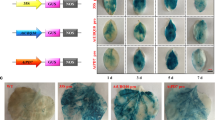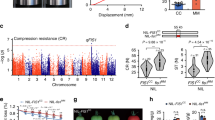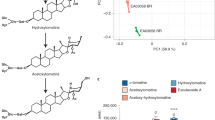Abstract
Monellin is a protein that elicits a flavor approximately 100,000 times sweeter than sugar on a molar basis. The protein exists naturally as a heterodimer, with its sweet flavor lost upon denaturation. A single–chain monellin gene, encoding both polypeptide chains linked by a hinge sequence, was placed under the control of constitutive and fruit–ripening specific promoters and transferred to lettuce and tomato. Expression of these genes in transgenic tomato and lettuce resulted in the accumulation of monellin protein in fruit and leaf, respectively, to significant levels. Production of monellin in transgenic fruits and vegetables represents an alternative strategy to enhance their flavor and quality.
This is a preview of subscription content, access via your institution
Access options
Subscribe to this journal
Receive 12 print issues and online access
$209.00 per year
only $17.42 per issue
Buy this article
- Purchase on Springer Link
- Instant access to full article PDF
Prices may be subject to local taxes which are calculated during checkout
Similar content being viewed by others
References
Morris, J.A. and Cagan, R.H. 1972. Purification of monellin, the sweet principle of Dioscoreophyllum cumminsii. Biochim. Biophys. Acta 261: 114–122.
Van der Wel, H. and Loeve, K. 1972. Isolation and characterization of thaumatin I and II, the sweet-tasting proteins from Thaumatococcus daniellii Benth. Eur. J. Biochem. 31: 221–225.
Bruwer, J.N., Hellekant, G., Kasahara, Y., Van der Wel, H. and Zotterman, Y. 1973. Electrophysiological study of the gustatory effects of the sweet proteins monellin and thaumatin in monkey, guinea pig and rat. Acta Physiol. Scand. 89: 550–557.
Van der Wal, H. and Arvidson, K. 1978. Qualitative psychophysical studies on the gustatory effects of the sweet tasting proteins thaumatin and monellin. Chem. Senses Flavor 3: 291–299.
Hawker, J.S. 1985. Biochemistry of Storage Carbohydrates in Green Plants, 1–51. Dey, P.M. and Dixon, R.A. (Eds.). Academic Press, London.
Shaw, D.V.J. 1988. Genotypic variation and genotypic correlations for sugars and organic acids of strawberries. Amer. Soc. Hort. Sci. 113: 770–774.
Frank, G. and Zuber, H. 1976. The complete amino acid sequences of both subunits of the sweet protein monellin. HoppeSeyler's Z. Physiol. Chem. 357: 585–592.
Hudson, G. and Biemann, K. 1976. Mass spectrometric sequencing of proteins. The structure of subunit I of monellin. Biochem. Biophys. Res. Com. 71: 212–220.
De Vos, A.M., Hatada, M., Van der Wel, H., Krabbedam, H., Peerdeman, A.F. and Kim, S.-H. 1985. Three-dimensional structure of thaumatin I, an intensely sweet protein. Proc. Nat. Acad. Sci. USA 82: 1406–1409.
Ogata, C., Hatada, M., Tomlinson, G., Shin, W.-C. and Kim, S.-H. 1987. Crystal structure of the intensely sweet protein monellin. Nature 328: 739–742.
Kim, S.-H., Kang, C.-H., Kim, R., Cho, J.M., Lee, Y.-B. and Lee, T.-K. 1989. Redesigning a sweet protein: increased stability and renaturability. Protein Engineering 2: 571–575.
Higginbotham, J.D. 1979. Protein sweeteners, 87–123. In: Developments in Sweeteners-1. Hough, C.A.M. and Parker, K.J. (Eds.). Applied Science Publishers, London.
Deikman, J. and Fischer, R.L. 1988. Interaction of a DNA binding factor with the 5′-flanking region of an ethylene-responsive fruit ripening gene from tomato. EMBO J. 7: 3315–3320.
Benfy, P.N., Ren, L. and Chau, N.-H 1989. The CaMV 355 enhancer contains at least two domains which can confer different developmental and tissue-specific expression patterns. EMBO J. 8: 2195–2202.
Lürssen, K. 1991. Ethylene and agriculture, p. 315–326. In: The Plant Hormone Ethylene. Mattoo, A.K. and Suttle, J.C. (Eds.). CRC Press, Boca Raton, FL.
Lincoln, J.E. and Fischer, R.L. 1988. Diverse mechanisms for the regulation of ethylene-inducible gene expression. Mol. Gen. Genet. 212: 71–75.
Witty, M. and Harvey, W.J. 1990. Sensory evaluation of transgenic Solanum tuberosum producing r-thaumatin II. New Zealand J. Crop Hortic. Sci. 18: 77–80.
Giovannoni, J.J., DellaPenna, D., Bennett, A.B. and Fischer, R.L. 1989. Expression of a chimeric polygalacturonase gene in transgenic rin (ripening inhibitor) tomato fruit results in polyuronide degradation but not fruit softening. The Plant Cell 1: 53–63.
Jefferson, R.A., Kavanagh, T.A. and Bevan, M.W. 1987. GUS fusions: β-glucuronidase as a sensitive and versatile gene fusion marker in higher plants. EMBO J. 6: 3901–3907.
Van Haute, E., Joos, H., Maes, M., Warren, G., Van Montagu, M. and Schell, J. 1983. Intergeneric transfer and exchange recombination of restriction fragments cloned in pBR322: a novel strategy for the reversed genetics of the Ti plasmids of Agrobacterium tumefaciens. EMBO J. 2: 411–417.
Fillatti, J.J., Kiser, R., Rose, B. and Comai, L. 1987. Efficient transformation of tomato and the introduction and expression of a gene for herbicide tolerance, p. 199–210. In: Tomato Biotechnology. Nevins, D.J. and Jones, R.A. (Eds.). Alan R. Liss, New York.
Bevan, M., 1984. Binary Agrobacterium vectors for plant transformation. Nuc. Acids Res. 12: 8711–8721.
Michelmore, R., Marsh, E., Seely, S. and Landry, B. 1987. Transformation of lettuce (Lactuca sativa) mediated by Agrobacterium tumefaciens. Plant Cell Reports 6: 439–442.
Ausubel, F.M., Brent, R., Kingson, R.E., Moore, D.D., Seidman, J.G., Smith, J.A. and Struhl, K. . 1989. Current Protocols in Molecular Biology. Greene Publishing Associates & Wiley-Interscience, New York.
Laemmli, U.K. 1970. Cleavage of structural proteins during the assembly of the head of bacteriophage T4. Nature 227: 680–685.
Schaffner, W. and Weissmann, C. 1973. A rapid, sensitive, and specific method for the determination of protein in dilute solution. Anal. Biochem. 56: 502–514.
Author information
Authors and Affiliations
Rights and permissions
About this article
Cite this article
Peñarrubia, L., Kim, R., Giovannoni, J. et al. Production of the Sweet Protein Monellin in Transgetic Plants. Nat Biotechnol 10, 561–564 (1992). https://doi.org/10.1038/nbt0592-561
Received:
Accepted:
Issue Date:
DOI: https://doi.org/10.1038/nbt0592-561
This article is cited by
-
High-level production of single chain monellin mutants with enhanced sweetness and stability in tobacco chloroplasts
Planta (2018)
-
Improving Flavour and Quality of Tomatoes by Expression of Synthetic Gene Encoding Sweet Protein Monellin
Molecular Biotechnology (2015)
-
From miracle fruit to transgenic tomato: mass production of the taste-modifying protein miraculin in transgenic plants
Plant Cell Reports (2012)



